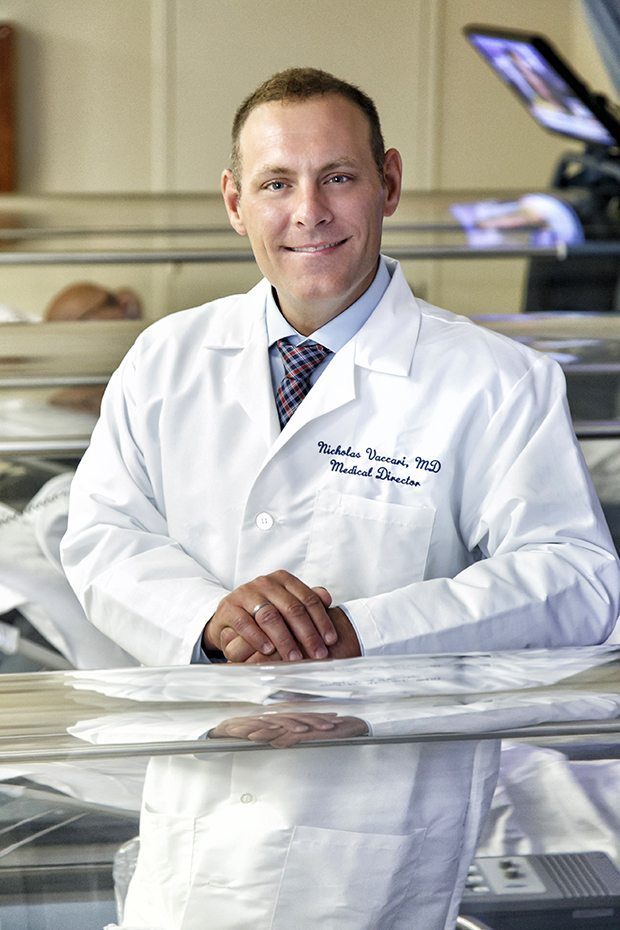
New york methodist hospital’s Wound Care and Hyperbaric Oxygen Therapy Center is making formerly challenging wounds heal easier, faster, and better
by Megan Schade • Photos By amessé photography
“The Marines taught me to keep calm and clear-headed under pressure,” said Nicholas Vaccari, M.D., an emergency medicine physician at New York Methodist Hospital (NYM) and medical director of NYM’s Wound Care and Hyperbaric Oxygen Therapy Center, “and they made sure that the pressure never stopped!” Though tough at the time, his military experience primed him for a life in emergency medicine. “I love the immediacy of emergency medicine. In one second, you become an integral part of a person’s life and plunge into the battle of diagnosis and treatment. I find it incredibly gratifying.”
One type of battle that intrigued Dr. Vaccari was wounds that would not heal. “Time and again, I’d see wounds in the emergency room—foot ulcers brought on by diabetes, surgical incisions that hadn’t closed, or burns—that didn’t respond to treatment. When NYM opened the Wound Care and Hyperbaric Oxygen Therapy Center, I was eager to be a part of it. ”
NYM’s Wound Care and Hyperbaric Oxygen Therapy Center serves patients with chronic, hard-to-heal wounds that fail to respond to other medical treatment. Dr. Vaccari, who was named medical director of the Center in 2013, said that diabetic foot ulcers are among the most common wounds treated there.
“Diabetes decreases blood flow to the legs and feet, so injuries are slower to heal,” Dr. Vaccari explained. “Furthermore, some people with diabetes may have reduced sensation in their hands or feet, which means a wound can go unnoticed—and untreated—for a dangerously long time.”
“Hyperbaric oxygen therapy (HBOT) is a treatment that can actually stimulate healing in previously non-healing foot ulcers, ,” said Ronald Soave, D.P.M., chief of podiatry at NYM. “For a time, conventional wisdom said that even the most conscientious diabetes patients would ultimately require an amputation due to complications from the illness. Thanks to HBOT, that notion is rapidly becoming outdated.”
The Center is one of the few facilities in the metropolitan area to offer HBOT, which involves breathing 100 percent oxygen while resting in a hyperbaric chamber that is pressurized two to three times more than normal air pressure. HBOT can significantly speed wound recovery by dramatically increasing blood oxygen levels in the body’s tissues. The increased oxygen levels promote the growth of new blood vessels, strengthen infection-fighting white blood cells, and encourage the growth of fibroblasts (cells involved in wound healing), positively affecting damaged tissue and non-healing wounds.
“HBOT treatment is intense, said Dr. Vaccari, “but so are the results. We customize each treatment plan to the individual patient, but typically, treatment takes between one and two hours, five days a week, for six weeks. Healing is a full-time job!”
Dr. Vaccari is quick to point out that the Center treats a wide array of wounds beyond foot ulcers. Other HBOT applications include the treatment of compromised skin grafts or flaps (patches of skin that have been surgically removed from one area of the body and then transplanted, or attached, to another area), soft tissue radionecrosis (death of cells in bones, organs, and soft tissues, primarily due to radiation therapy for cancer), and chronic refractory osteomyelitis (a bacterial infection involving bone) that fails to heal despite adequate surgical and antibiotic therapy.
The Center also offers state-of-the-art grafting technologies. Skin grafting is a surgical procedure in which skin or a skin substitute is placed over a non-healing wound. Dr. Vaccari said that, “we are lucky to work with Richard Reish, M.D. and Joshua Zuckerman, M.D., plastic surgeons at NYM, who are doing incredible work in the area of grafting.” Depending on the type of wound, needs of the patient, and chosen plan of treatment, a variety of grafting options, using bioengineered skin, synthetic skin or organic tissue, are available.
“Our Center is, by its nature, multidisciplinary,” said Dr. Vaccari. “Non-healing wounds can occur in many medical specialties, including surgery, podiatry, urology, or dentistry. The primary physician and every doctor involved in the case are inherent members of our team, and are kept fully apprised of each patients’ treatment and progress.”
Dr. Vaccari added that nurses are an integral part of the Center. “Not only do they ensure that every supply needed is waiting for us, and the patient’s protocol is on point throughout the procedure, they make sure the patient feels comfortable and understood while they are here. Patients spend a lot of time with us; we want them to enjoy coming here as much as they can, and the nurses are a critical part of our success.”
“Having the Wound Care and Hyperbaric Center so near the Hospital allows for comprehensive treatment,” offered Michael Shapiro, M.D, vascular surgeon at NYM. “The physicians are able to easily come together and collaborate on the best treatment course for the patients, and the patient benefits from having all needed services nearby. It’s a win-win.”
“I am so lucky to work with such a smart and compassionate team of doctors and nurses. I live in the neighborhood and my children all go to school here. It is important to me to do something for the community that I am proud of, and I am very proud of this Center. One of the things that is so nice about the physicians and staff I work with here at NYM—it isn’t ‘My patient, my case, my plan,’ it’s ‘Our patient, our case, our plan.’ I truly feel that the attitude of a patient can affect their treatment, it is the job of our staff to help these patients visualize a life beyond their wounds.”
New York Methodist Hospital
506 Sixth Street / 718.780.3000 / nym.org







